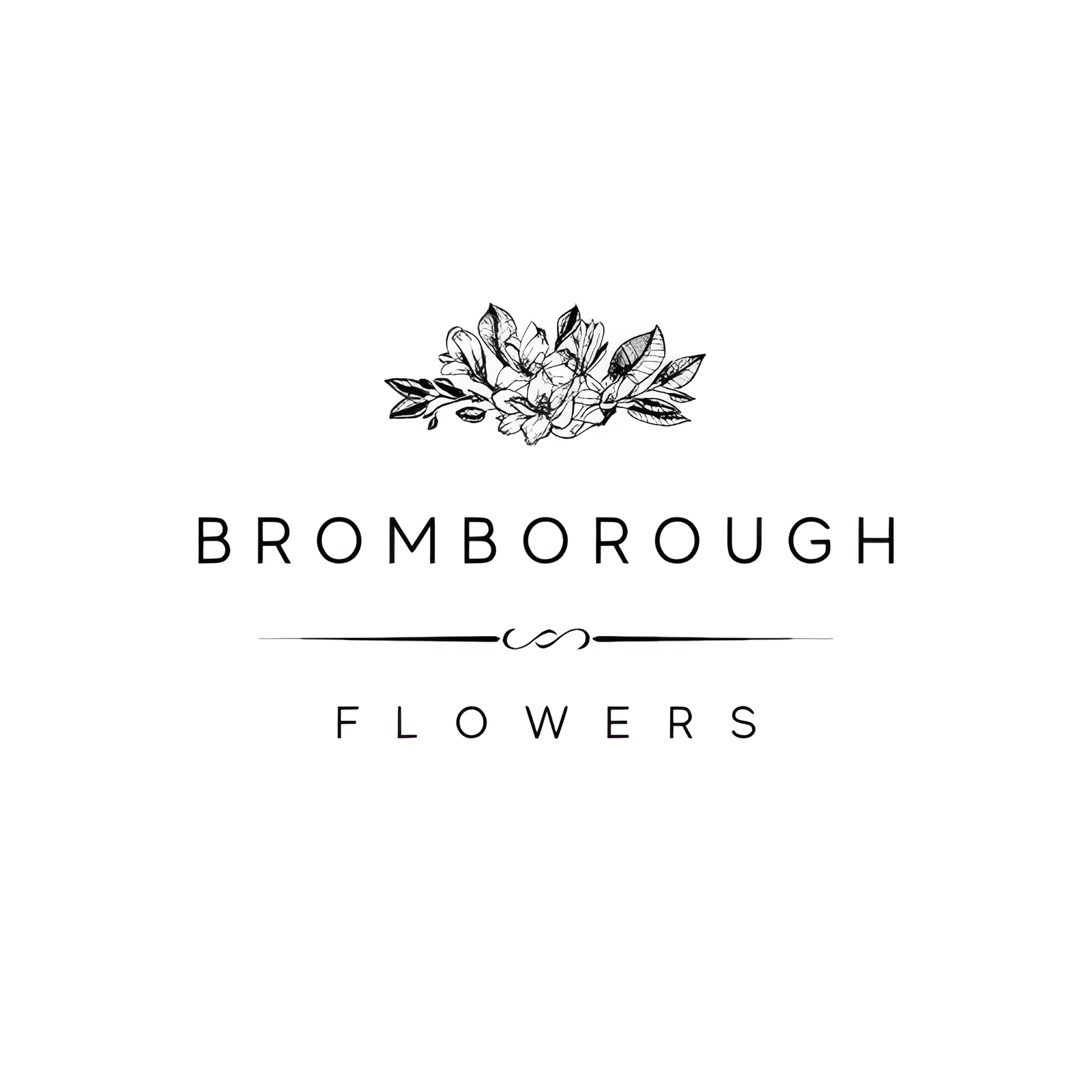As couples seek to infuse their wedding ceremonies with a blend of vintage elegance and enchanting charm, Hollyhocks emerge as an ideal floral choice. These flowers, with their impressive height and double salmon-pink or pure white blooms, evoke a romantic, fairy-tale ambiance perfect for garden-themed, rustic, or bohemian-style weddings. More than just visually captivating, Hollyhocks carry symbolic meanings of ambition, growth, and positivity. This guide aims to explore the multifaceted aspects of Hollyhocks, from their taxonomy and geographical origins to their cultural significance and best growing conditions. So, what makes Hollyhocks an unparalleled choice for wedding florals?
Flower Overview
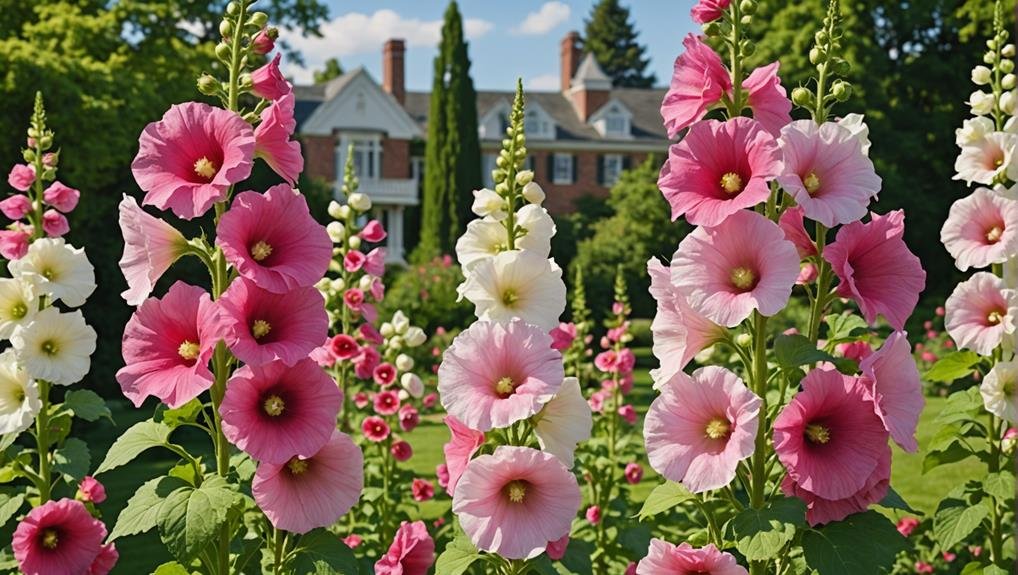
The Brides Bouquet Hollyhocks are renowned for their large, glowing double salmon-pink and pure-white fully-double flowers that bloom in early to mid-summer. These stunning blooms stand out in any garden, providing an enchanting display that is ideal for various ornamental purposes, especially in creating a picturesque backdrop for spring weddings. Their eye-catching colors and impressive flower spikes make them a favored choice among gardeners and floral designers alike.
Brides Bouquet Hollyhock thrives best in rich soil with regular watering. Ensuring that the soil remains moist but well-drained is key to achieving prime growth and bloom potential. These hollyhocks are winter hardy down to zone 3, making them adaptable to a variety of climates, which further enhances their appeal. Their robust nature means that they can endure colder temperatures without compromising their flowering capabilities.
Not only are Brides Bouquet Hollyhocks low maintenance, but they also attract birds and butterflies, adding an element of natural beauty and biodiversity to any outdoor space. Their ability to draw in pollinators makes them an excellent addition to eco-friendly gardens.
Physical Description
Standing tall and commanding attention, Brides Bouquet Hollyhocks reach an impressive height of 5-7 feet, making them a majestic addition to any landscape. These towering beauties are a sight to behold, providing a vertical element that enhances garden aesthetics and wedding arrangements alike.
The bloom of a Hollyhock is nothing short of spectacular. Brides Bouquet Hollyhocks are renowned for their large, glowing double salmon-pink and pure-white fully-double flowers. These blooms typically make their appearance in early to mid-summer, offering a romantic and timeless appeal to any setting. The flowers are densely packed along the tall, sturdy stems, creating a lush and vibrant display that is sure to captivate onlookers.
Hollyhocks are winter hardy to zone 3, showcasing their resilience and adaptability across various climates. Their best performance is achieved with rich soil and regular watering, ensuring their impressive stature and abundant blooms.
- Stunning height: Reaching 5-7 feet, they create a vertical focal point.
- Dense blooms: Large, double flowers densely packed along stems.
- Seasonal charm: Blooms in early to mid-summer, perfect for romantic settings.
- Hardy nature: Winter hardy to zone 3, adaptable to various climates.
Available Colour Varieties
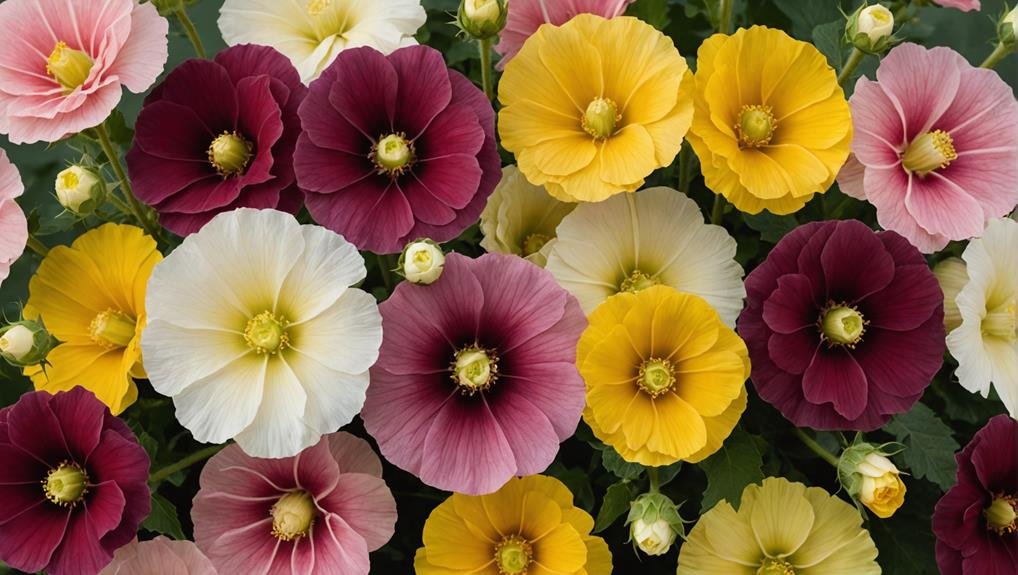
Hollyhocks offer a stunning array of color varieties, including double salmon-pink and pure white, that enhance the beauty of any wedding arrangement. This vibrant spectrum of hues allows for creative and personalized combinations in floral decor, ensuring that each wedding can have a unique and memorable aesthetic.
Among the most popular choices are the Brides Bouquet hollyhocks, renowned for their large, glowing double salmon-pink flowers paired with pure white, fully-double blooms. These color varieties not only add visual appeal but also provide versatility in matching the theme and color scheme of any wedding or special event.
The rich palette of hollyhocks can seamlessly integrate with various design concepts, whether aiming for a classic, romantic, or modern look.
Furthermore, the diverse color options of hollyhocks enable florists to craft intricate and harmonious arrangements that cater to the specific preferences of brides and grooms. From vibrant and bold to soft and delicate, hollyhocks' color varieties play an essential role in enhancing the overall ambiance and aesthetic of wedding decorations.
Their adaptability and striking beauty make hollyhocks an excellent choice for creating stunning and unforgettable floral displays.
Latin Name and Taxonomy
Known scientifically as Alcea rosea, this elegant plant belongs to the Malvaceae family and is distinguished by its tall spikes of vibrant, cup-shaped flowers. As a member of the taxonomy hierarchy, hollyhocks are classified under the kingdom Plantae, order Malvales, and genus Alcea. This classification reflects their botanical lineage and aids in understanding their unique characteristics and biological relationships.
Hollyhocks are biennial or short-lived perennial plants that can add a distinctive touch of charm and height to any garden setting. Their striking floral displays are not only visually appealing but also offer a glimpse into the intricate world of plant taxonomy. The following features of Alcea rosea contribute to its enduring popularity:
- Tall, majestic spikes that can reach up to several feet in height, making them a focal point in floral arrangements.
- A variety of vibrant colors, including shades of pink, red, white, yellow, and purple, providing versatile options for wedding themes.
- Cup-shaped flowers that offer a classic and elegant appearance.
- Historical cultivation in gardens across Asia and Europe for centuries, highlighting their ornamental value.
Understanding the taxonomy of hollyhocks fosters a deeper appreciation for their role in horticulture and wedding decor.
Geographical Origins
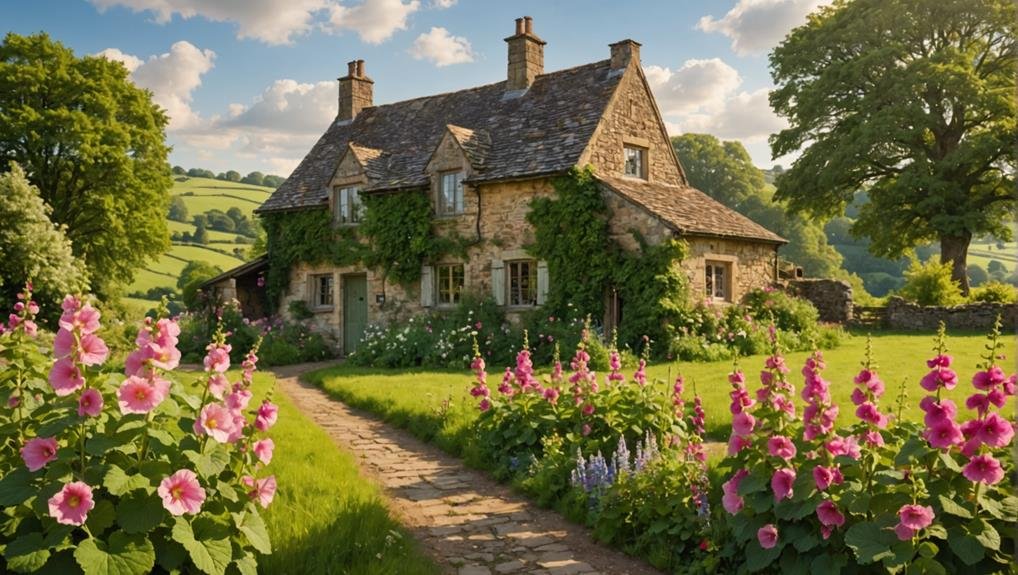
Originating from regions like China, India, and the Mediterranean, hollyhocks have a rich history of cultivation across Asia and Europe. These striking plants have been a staple in gardens for centuries, admired for their tall, stately flower spikes and vibrant blooms. As members of the Malvaceae family, hollyhocks share their lineage with other notable plants such as hibiscus and okra, underscoring their ornamental and historical significance.
The geographical origins of hollyhocks reveal their adaptability to various temperate climates. In China, these flowers have been cultivated not just for their aesthetic appeal but also for their medicinal properties. The Mediterranean region, with its favorable climate, has provided an ideal environment for hollyhocks to thrive and proliferate. Similarly, in India, hollyhocks have been a common sight in traditional gardens, contributing to the rich tapestry of local flora.
Below is a table summarizing the key regions associated with hollyhock cultivation:
| Region | Notable Aspects | Historical Significance |
|---|---|---|
| China | Medicinal uses, ornamental | Centuries of cultivation |
| India | Traditional garden plant | Cultural and aesthetic value |
| Mediterranean | Ideal climatic conditions | Prolific growth and spread |
| Europe | Garden staple, ornamental | Historical garden favorite |
Understanding the geographical origins of hollyhocks provides valuable insight into their enduring appeal and versatility in garden design.
Season Availability
Blooming mainly in early to mid-summer, hollyhocks offer an ideal floral option for weddings held during this season. Their vibrant colors and towering presence make them an alluring choice for any summer celebration. Hollyhocks are winter hardy to zone 3, ensuring their availability in cooler climates, and can be sown in early spring to guarantee summer blooms. This timing allows ample preparation for the big day, ensuring that these exquisite flowers are at their peak.
In late summer, hollyhocks continue to stand tall, providing a magical backdrop for weddings that extend into this season. Their double salmon-pink and pure-white flowers add a romantic touch, blending seamlessly with various wedding themes and color palettes. These blooms are not only visually stunning but also versatile in their use, enhancing the ambiance of the event with their elegance and charm.
Hollyhocks can be used in various ways for event decor, including:
- Bouquets: Creating lush, romantic arrangements.
- Arches: Forming enchanting floral arches for the ceremony.
- Table centerpieces: Adding height and drama to reception tables.
- Backdrop displays: Serving as picturesque backgrounds for wedding photos.
Growing Conditions
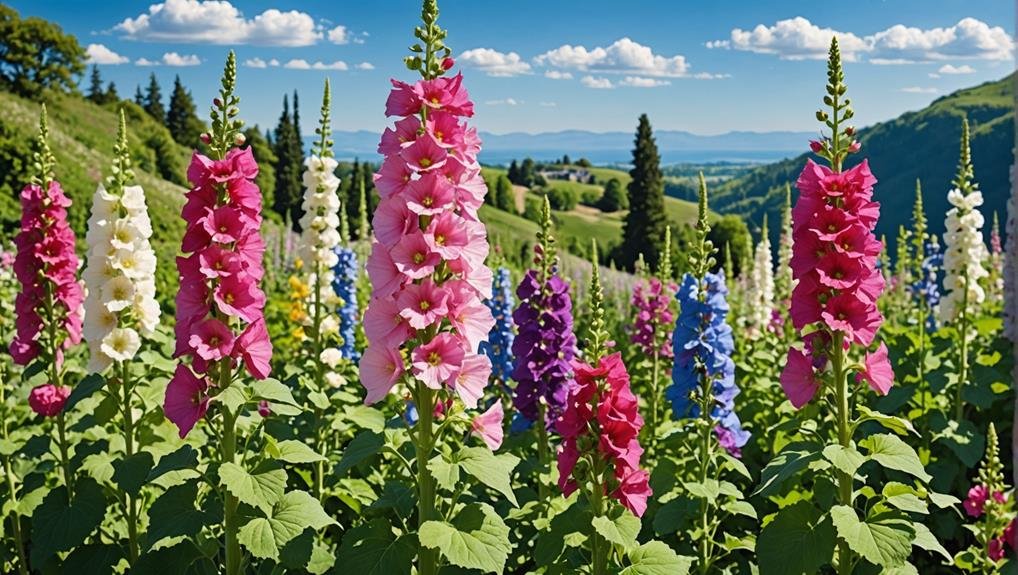
Thriving in full sun, hollyhocks are best suited for growth in zones 3-9, where they can flourish with minimal maintenance. These garden flowers are ideal for creating a vibrant, lively atmosphere, attracting both birds and butterflies to your garden. Hollyhocks bloom in the summer and can reach impressive heights of 5-7 feet, making them a striking addition to any outdoor space.
To maximize growth, it is essential to follow proper planting guidelines. Begin by sowing seeds individually in moist compost. Germination typically occurs within 10-14 days. By June, the young plants will be ready for garden planting. Ensuring your hollyhocks receive adequate sunlight and are placed in well-draining soil will foster healthy growth and abundant blooms.
Here is a summary of key growing conditions:
| Condition | Details |
|---|---|
| Sunlight | Full sun |
| Growth Zones | 3-9 |
| Bloom Season | Summer |
| Height | 5-7 feet |
| Planting Time | June (after germination) |
| Germination | 10-14 days in moist compost |
Cultural Significance
How have hollyhocks, with their rich symbolic meanings and historical uses, shaped cultural traditions across various societies?
The cultural significance of hollyhocks is deeply rooted in diverse traditions and practices. Known for symbolizing ambition, fertility, and fruitfulness, these flowers have found a place in the folklore and mythology of numerous cultures. Historically, hollyhocks have been employed in traditional medicine and herbal remedies, reflecting their multifaceted utility.
In Victorian times, hollyhocks were commonly associated with home and family, often planted near houses to bring positive energy and protection. This practice underscores their role as symbols of good luck and guardianship in many cultural narratives. The vibrant colors and towering structures of hollyhocks also contribute to their popularity in gardens and decorative settings, enhancing their aesthetic appeal and cultural value.
Ambition and Aspiration:
Hollyhocks are often seen as symbols of ambition, inspiring growth and progress.
Fertility and Fruitfulness:
Their association with fertility makes them significant in rituals and celebrations.
Protection and Good Luck:
Featured in folklore as protective charms against evil.
Home and Family:
Planted near homes for positive energy and familial harmony.
The cultural significance of hollyhocks continues to enrich traditions, making them cherished in various societies.
Typical Use in Weddings
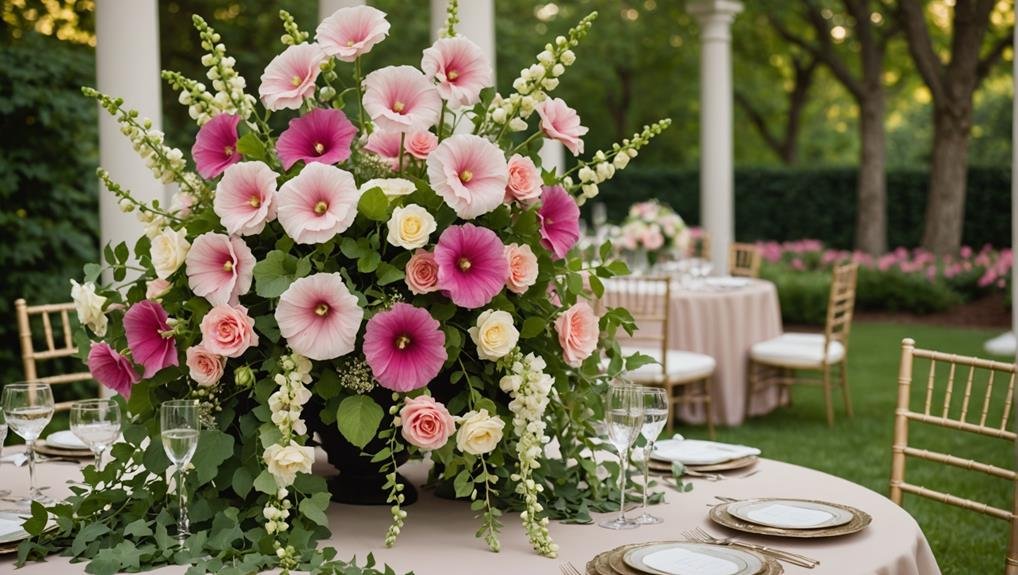
Drawing from their rich cultural significance, hollyhocks have become a favored choice in weddings for their tall, elegant flower spikes and romantic, vintage charm. These flowers are particularly popular in garden-themed weddings, rustic outdoor ceremonies, and bohemian-style events. Their ability to evoke a whimsical, fairy-tale ambiance makes them a versatile addition to wedding decor.
Hollyhocks can be seamlessly incorporated into various aspects of wedding arrangements. They make striking additions to bridal bouquets, adding height and a touch of nostalgia. Centerpieces featuring hollyhocks offer a captivating focal point for reception tables, enhancing the overall aesthetic with their unique presence. Additionally, these flowers are often used to adorn wedding arches, creating a picturesque backdrop for ceremonies.
Moreover, hollyhocks are ideal for DIY floral arrangements, allowing for creative expression and personalization. Whether mixed with other flowers or showcased alone, they deliver a stunning visual impact. Their adaptability ensures they complement a wide range of wedding styles and themes, from the most formal to the delightfully informal.
Alternative Flower Types
When planning wedding floral arrangements, considering alternative flower types such as Zinnias, Bells of Ireland, and Carnations can offer unique and enchanting options. These flowers, recognized for their beauty and versatility, can add a personalized touch to any wedding theme. Bells of Ireland, with their striking green hue and tall, elegant stems, can create a stunning contrast in bouquets and centerpieces.
In addition to these primary alternatives, a variety of other flowers and foliage can be incorporated to enhance the overall aesthetic:
- Globe Amaranth: Recognized for their vibrant colors and spherical shape, these flowers can add a playful element to arrangements.
- Cornflowers: These delicate, blue flowers are ideal for a subtle yet striking addition.
- White Bishops Lace: This airy, lacy flower can offer a soft, romantic feel to any bouquet.
- Cerinthe: Ideal for wearable floral accessories, adding a unique and whimsical touch.
Incorporating herbs and foliage from garden shrubs can further personalize and extend bouquet arrangements. Opting for flowers like Rudbeckia that bloom freely in the year after sowing guarantees their availability for wedding events.
This thoughtful approach to selecting wedding flowers can lead to a truly memorable and distinctive celebration.
